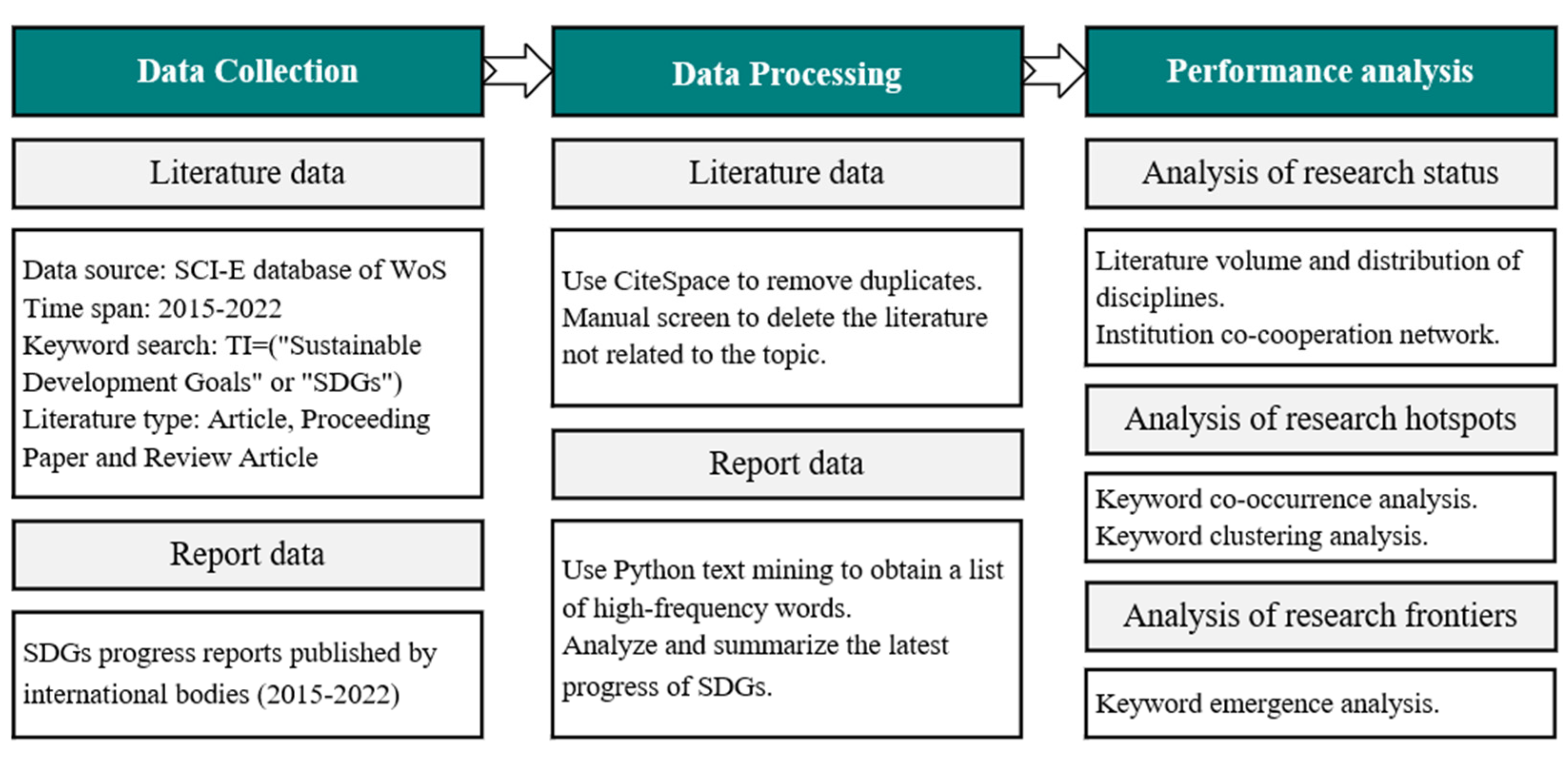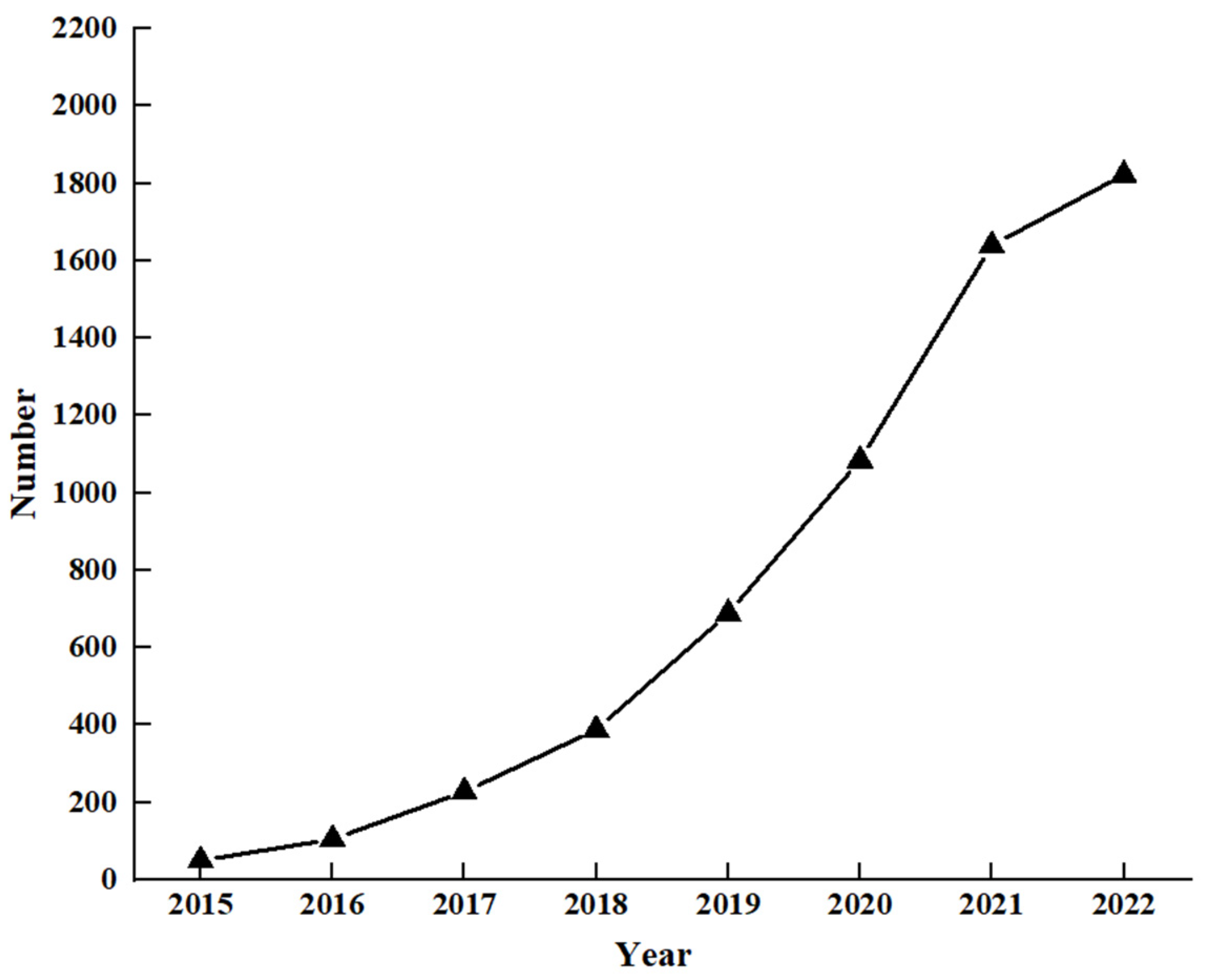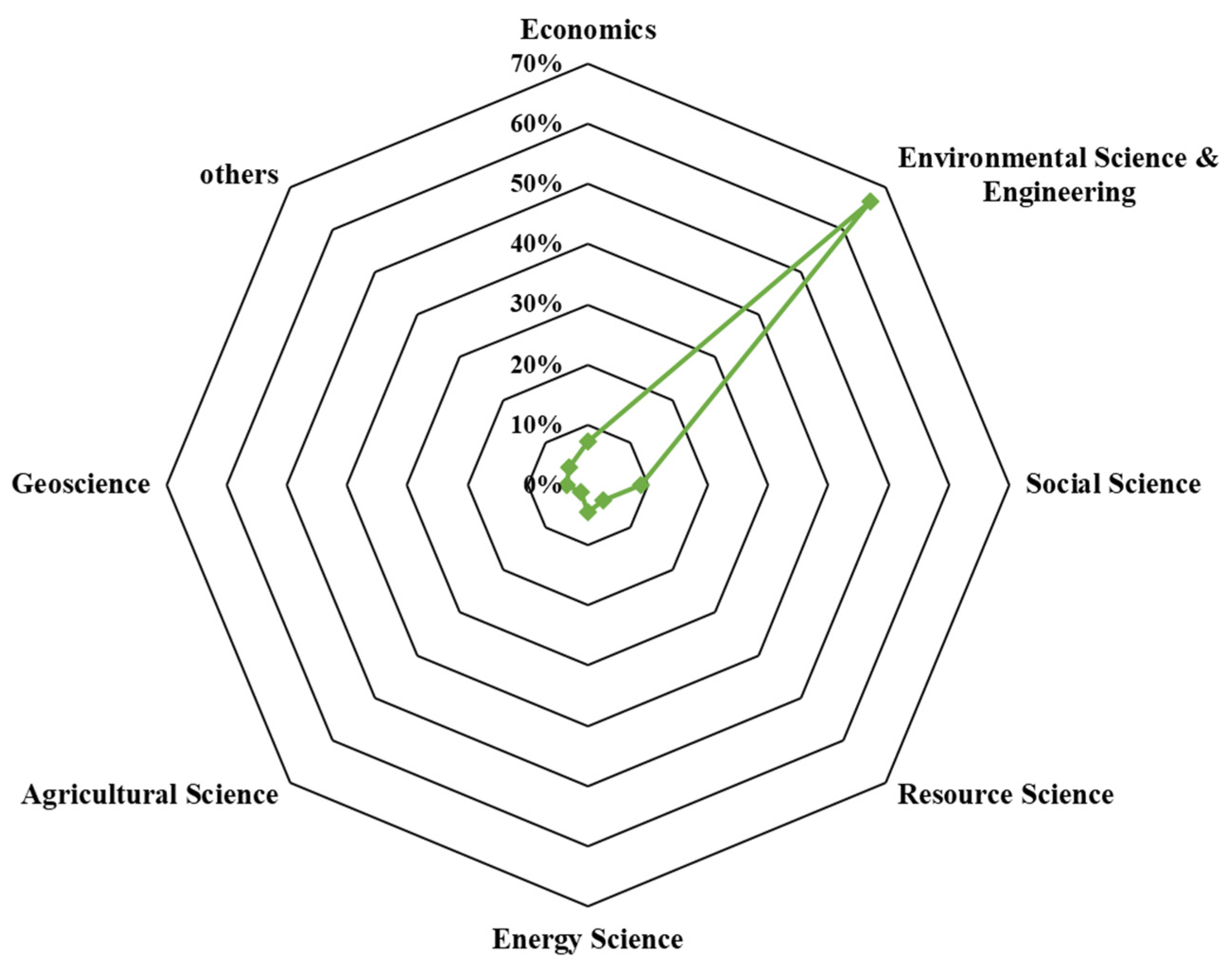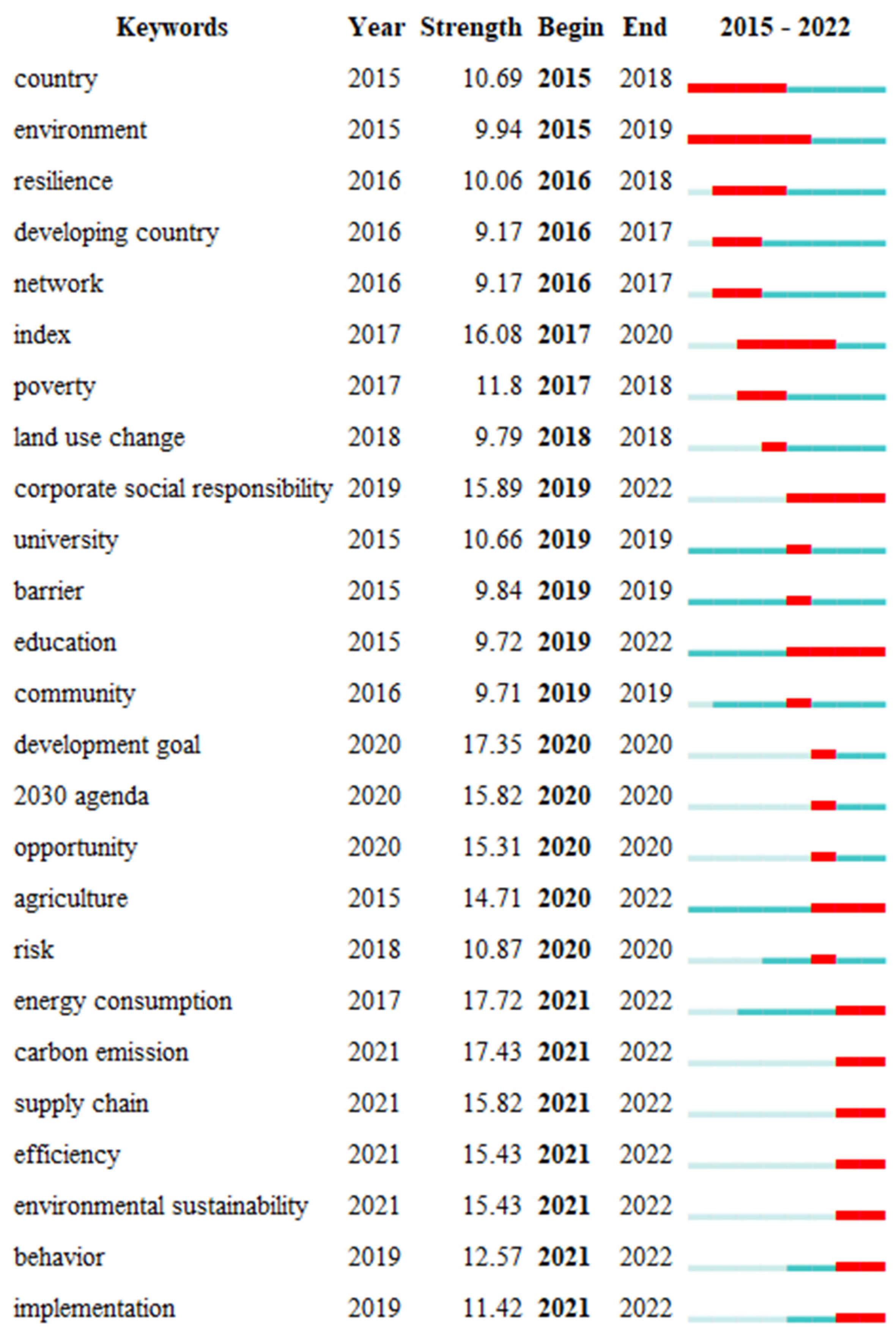Bibliometric Analysis of Research Hotspots and Frontiers in Progress towards the Sustainable Development Goals
Abstract
1. Introduction
2. Materials and Methods
3. Results and Discussion
3.1. Analysis of Research Status
3.1.1. Literature Volume and Distribution of Disciplines
3.1.2. Research Institutions
3.2. Analysis of Research Hotspots
3.2.1. Keyword Co-Occurrence
3.2.2. Keyword Clustering
- (1)
- Different responsible entities to advance the implementation of the SDGs
- (2)
- SDGs Progress Evaluation Methodology
- (3)
- Scientific Study of SDGs Indicators
- (4)
- Interaction studies between SDGs objectives
3.3. Evolution of Research Hotspots and Analysis of Research Frontiers
4. Conclusions
Author Contributions
Funding
Institutional Review Board Statement
Informed Consent Statement
Data Availability Statement
Acknowledgments
Conflicts of Interest
References
- United Nations. Transforming Our World: The 2030 Agenda for Sustainable Development. Resolution Adopted by the General Assembly on 25 September 2015; United Nations: New York, NY, USA, 2015; Available online: https://www.un.org/sustainabledevelopment/development-agenda/ (accessed on 30 November 2023).
- United Nations. Take Action for the Sustainable Development Goals. Available online: https://www.un.org/sustainabledevelopment/sustainable-development-goals/ (accessed on 30 November 2023).
- Halisçelik, E.; Soytas, M.A. Sustainable development from millennium 2015 to Sustainable Development Goals 2030. Sustain. Dev. 2019, 27, 545–572. [Google Scholar] [CrossRef]
- Richardson, K.; Steffen, W.; Lucht, W.; Bendtsen, J.; Cornell, S.E.; Donges, J.F.; Drüke, M.; Fetzer, I.; Bala, G.; von Bloh, W.; et al. Earth beyond six of nine Planetary Boundaries. Sci. Adv. 2023, 9, 37. [Google Scholar] [CrossRef]
- Steffen, W.; Richardson, K.; Rockström, J.; Cornell, S.E.; Fetzer, I.; Bennett, E.M.; Biggs, R.; Carpenter, S.R.; de Vries, W.; de Wit, C.A.; et al. Planetary boundaries: Guiding human development on a changing planet. Science 2015, 347, 1259855. [Google Scholar] [CrossRef]
- Allen, C.; Smith, M.; Rabiee, M.; Dahmm, H. A review of scientific advancements in datasets derived from big data for monitoring the Sustainable Development Goals. Sustain. Sci. 2021, 16, 1701–1716. [Google Scholar] [CrossRef]
- Yonehara, A.; Saito, O.; Hayashi, K.; Nagao, M.; Yanagisawa, R.; Matsuyama, K. The role of evaluation in achieving the SDGs. Sustain. Sci. 2017, 12, 969–973. [Google Scholar] [CrossRef]
- Elsevier. The Power of Data to Advance the SDGs: Mapping Research for the Sustainable Development Goals; Elsevier: London, UK, 2020. [Google Scholar]
- Wu, L.B.; Pan, J.W.; Zhang, X.; Ma, Z.Y.; Lin, S.; Xia, T.Y.; Wang, Q.Q.; Zhang, Q. Action Report of Higher Education in China about SDGs; Fudan University: Shanghai, China, 2021. [Google Scholar]
- Allen, C.; Metternicht, G.; Wiedmann, T. Initial progress in implementing the Sustainable Development Goals (SDGs): A review of evidence from countries. Sustain. Sci. 2018, 13, 1453–1467. [Google Scholar] [CrossRef]
- Castro, G.D.; Fernández, M.C.G.; Colsa, A.U. Unleashing the convergence amid digitalization and sustainability towards pursuing the Sustainable Development Goals (SDGs): A holistic review. J. Clean. Prod. 2021, 280, 122204. [Google Scholar] [CrossRef]
- Vanham, D.; Leip, A.; Galli, A.; Kastner, T.; Bruckner, M.; Uwizeye, A.; van Dijk, K.; Ercin, E.; Dalin, C.; Brandao, M.; et al. Environmental footprint family to address local to planetary sustainability and deliver on the SDGs. Sci. Total Environ. 2019, 693, 133642. [Google Scholar] [CrossRef] [PubMed]
- Chen, C.; Chen, Y.; Hou, J.; Liang, Y. CiteSpace I: Detecting and visualizing emerging trends and transient patterns in scientific literature. J. China Soc. Sci. Tech. Inf. 2009, 28, 401–421. [Google Scholar] [CrossRef]
- United Nations Department of Economic and Social Affairs. Progress towards the Sustainable Development Goals: Report of the Secretary-General; United Nations: New York, NY, USA, 2022. [Google Scholar]
- Allen, C.; Metternicht, G.; Wiedmann, T.; Pedercini, M. Greater gains for Australia by tackling all SDGs but the last steps will be the most challenging. Nat. Sustain. 2019, 2, 1041–1050. [Google Scholar] [CrossRef]
- Sachs, J.; Lafortune, G.; Kroll, C.; Fuller, G.; Woelm, F. From Crisis to Sustainable Development: The SDGs as Roadmap to 2030 and Beyond. Sustainable Development Report 2022; Cambridge University Press: Cambridge, UK, 2022. [Google Scholar]
- De Villiers, C.; Kuruppu, S.; Dissanayake, D. A (new) role for business-Promoting the United Nations’ Sustainable Development Goals through the internet-of-things and blockchain technology. J. Bus. Res. 2021, 131, 598–609. [Google Scholar] [CrossRef]
- Song, L.; Zhan, X.; Zhang, H.; Xu, M.; Liu, J.; Zheng, C. How much is global business sectors contributing to sustainable development goals? Sustain. Horiz. 2022, 1, 100012. [Google Scholar] [CrossRef]
- Vazquez-Brust, D.; Piao, R.S.; de Melo, M.F.D.; Yaryd, R.T.; Carvalho, M.M. The governance of collaboration for sustainable development: Exploring the “black box”. J. Clean. Prod. 2020, 256, 120260. [Google Scholar] [CrossRef]
- Dahlmann, F.; Stubbs, W.; Griggs, D.; Morrell, K. Corporate actors, the UN Sustainable Development Goals and Earth System Governance: A research agenda. Anthr. Rev. 2019, 6, 167–176. [Google Scholar] [CrossRef]
- Appolloni, A.; Centi, G.; Yang, N. Promoting carbon circularity for a sustainable and resilience fashion industry. Curr. Opin. Green Sustain. Chem. 2023, 39, 100719. [Google Scholar] [CrossRef]
- Zafar, A.U.; Shahzad, M.; Shahzad, K.; Appolloni, A.; Elgammal, I. Gamification and sustainable development: Role of gamified learning in sustainable purchasing. Technol. Forecast. Soc. Chang. 2024, 198, 122968. [Google Scholar] [CrossRef]
- Rashid, L. Entrepreneurship Education and Sustainable Development Goals: A literature Review and a Closer Look at Fragile States and Technology-Enabled Approaches. Sustainability 2019, 11, 5343. [Google Scholar] [CrossRef]
- Li, L.; Xia, X.H.; Chen, B.; Sun, L.X. Public participation in achieving sustainable development goals in China: Evidence from the practice of air pollution control. J. Clean. Prod. 2018, 201, 499–506. [Google Scholar] [CrossRef]
- Huan, Y.; Liang, T.; Li, H.; Zhang, C. A systematic method for assessing progress of achieving sustainable development goals: A case study of 15 countries. Sci. Total Environ. 2021, 752, 141875. [Google Scholar] [CrossRef] [PubMed]
- Schmidt-Traub, G.; Kroll, C.; Teksoz, K.; Durand-Delacre, D.; Sachs, J.D. National baselines for the Sustainable Development Goals assessed in the SDG Index and Dashboards. Nat. Geosci. 2017, 10, 547. [Google Scholar] [CrossRef]
- Zhou, Q.; Dong, Z.F.; Pan, R.X. Policy analysis and recommendations of Sustainable Development Report 2019: Transformations to Achieve the Sustainable Development Goals: Includes the SDG Index and Dashboards. Environ. Sustain. Dev. 2021, 46, 95–101. [Google Scholar] [CrossRef]
- Zhu, X.F.; Yang, Y.H.; Wang, H.S.; Li, Y.B.; Zheng, Y.; Ye, Y.X. Research Report on Local Evaluation and Prospects of China’s Sustainable Development Goals–Measurement Based on Provincial Data from 2004–2017; Tsinghua University: Beijing, China, 2020. [Google Scholar]
- Allen, C.; Nejdawi, R.; El-Baba, J.; Hamati, K.; Metternicht, G.; Wiedmann, T. Indicator-based assessments of progress towards the sustainable development goals (SDGs): A case study from the Arab region. Sustain. Sci. 2017, 12, 975–989. [Google Scholar] [CrossRef]
- Jones, P.; Comfort, D. A commentary on the localisation of the sustainable development goals. J. Public Aff. 2020, 20, e1943. [Google Scholar] [CrossRef]
- Dang, H.A.H.; Serajuddin, U. Tracking the sustainable development goals: Emerging measurement challenges and further reflections. World Dev. 2020, 127, 104570. [Google Scholar] [CrossRef]
- Guo, H.; Liang, D.; Sun, Z.; Chen, F.; Wang, X.; Li, J.; Zhu, L.; Bian, J.; Wei, Y.; Huang, L.; et al. Measuring and evaluating SDG indicators with Big Earth Data. Sci. Bull. 2022, 67, 1792–1801. [Google Scholar] [CrossRef] [PubMed]
- Ishtiaque, A.; Masrur, A.; Rabby, Y.W.; Jerin, T.; Dewan, A. Remote Sensing-Based Research for Monitoring Progress towards SDG 15 in Bangladesh: A Review. Remote Sens. 2020, 12, 691. [Google Scholar] [CrossRef]
- Wang, M.J.; Wang, Y.J.; Teng, F.; Li, S.C.; Lin, Y.H.; Cai, H.F. China’s poverty assessment and analysis under the framework of the UN SDGs based on multisource remote sensing data. Geo-Spat. Inf. Sci. 2022, 17, 1–21. [Google Scholar] [CrossRef]
- Liang, A.N.; Yan, D.M.; Yan, J.; Lu, Y.Y.; Wang, X.W.; Wu, W.R. A Comprehensive Assessment of Sustainable Development of Urbanization in Hainan Island Using Remote Sensing Products and Statistical Data. Sustainability 2023, 15, 979. [Google Scholar] [CrossRef]
- Sachs, J.; Schmidt-Traub, G.; Kroll, C.; Durand-Delacre, D.; Teksoz, K. SDG Index and Dashboards Report 2017; Bertelsmann Stiftung and Sustainable Development Solutions Network (SDSN): New York, NY, USA, 2017. [Google Scholar]
- Hall, N.L.; Matthews, S.; Hickson, A.; Hill, P.S. Health and the Sustainable Development Goals: Challenges for four Pacific countries. Int. J. Health Plan. Manag. 2019, 34, E844–E859. [Google Scholar] [CrossRef] [PubMed]
- Giles-Corti, B.; Lowe, M.; Arundel, J. Achieving the SDGs: Evaluating indicators to be used to benchmark and monitor progress towards creating healthy and sustainable cities. Health Policy 2020, 124, 581–590. [Google Scholar] [CrossRef] [PubMed]
- Wang, J.; Liu, Q.Z.; Meng, L.B.; Cao, L.; Zhang, X.H.; Zhang, X.D. Analyzing on the SDG Indicator 12.7.1 Methodology. Chin. J. Environ. Manag. 2021, 13, 96–100. [Google Scholar] [CrossRef]
- McCracken, M.; Meyer, C. Monitoring of transboundary water cooperation: Review of Sustainable Development GoalIndicator 6.5.2 methodology. J. Hydrol. 2018, 563, 1–12. [Google Scholar] [CrossRef]
- UNEP (United Nations Environment Programme). Inclusive Wealth Report 2018. Available online: https://www.unenvironment.org/resources/report/inclusive-wealthreport-2018 (accessed on 5 December 2023).
- Fuso Nerini, F.; Tomei, J.; To, L.S.; Bisaga, I.; Parikh, P.; Black, M.; Borrion, A.; Spataru, C.; Castán Broto, V.; Anandarajah, G.; et al. Mapping synergies and trade-offs between energy and the Sustainable Development Goals. Nat. Energy 2017, 3, 10–15. [Google Scholar] [CrossRef]
- Miola, A.; Borchardt, S.; Neher, F.; Buscaglia, D. Interlinkages and Policy Coherence for the Sustainable Development Goals Implementation: An Operational Method to Identify Trade-Offs and Co-Benefits in a Systemic Way; Publications Office of the European Union: Luxembourg, 2019. [Google Scholar]
- Nilsson, M.; Griggs, D.; Visbeck, M. Map the interactions between Sustainable Development Goals. Nature 2016, 534, 320–322. [Google Scholar] [CrossRef]
- Collste, D.; Pedercini, M.; Cornell, S.E. Policy coherence to achieve the SDGs: Using integrated simulation models to assess effective policies. Sustain. Sci. 2017, 12, 921–931. [Google Scholar] [CrossRef] [PubMed]
- van Soest, H.L.; van Vuuren, D.P.; Hilaire, J.; Minx, J.C.; Harmsen, M.J.H.M.; Krey, V.; Popp, A.; Riahi, K.; Luderer, G. Analysing interactions among Sustainable Development Goals with Integrated Assessment Models. Glob. Transit. 2019, 1, 210–225. [Google Scholar] [CrossRef]
- McCollum, D.L.; Echeverri, L.G.; Busch, S.; Pachauri, S.; Parkinson, S.; Rogelj, J.; Krey, V.; Minx, J.C.; Nilsson, M.; Stevance, A.S.; et al. Connecting the sustainable development goals by their energy inter-linkages. Environ. Res. Lett. 2018, 13, 23. [Google Scholar] [CrossRef]
- von Stechow, C.; Minx, J.C.; Riahi, K.; Jewell, J.; McCollum, D.L.; Callaghan, M.W.; Bertram, C.; Luderer, G.; Baiocchi, G. 2 °C and SDGs: United they stand, divided they fall? Environ. Res. Lett. 2016, 11, 034022. [Google Scholar] [CrossRef]
- Mantlana, K.B.; Maoela, M.A. Mapping the interlinkages between sustainable development goal 9 and other sustainable development goals: A preliminary exploration. Bus. Strategy Dev. 2020, 3, 344–355. [Google Scholar] [CrossRef]
- Zhang, J.; Wang, S.; Pradhan, P.; Zhao, W.; Fu, B. Mapping the complexity of the food-energy-water nexus from the lens of Sustainable Development Goals in China. Resour. Conserv. Recycl. 2022, 183, 106357. [Google Scholar] [CrossRef]
- Cheng, Y.; Wang, J.; Shu, K. The coupling and coordination assessment of food-water-energy systems in China based on sustainable development goals. Sustain. Prod. Consum. 2023, 35, 338–348. [Google Scholar] [CrossRef]
- Molefe, T.; Inglesi-Lotz, R. Examining the water-energy-food (WEF) nexus through an SDG lens for the big 5 African countries. Environ. Dev. Sustain. 2022, 25, 14083–14100. [Google Scholar] [CrossRef]
- Zhu, J.; Kang, S.; Zhao, W.; Li, Q.; Xie, X.; Hu, X. A Bibliometric Analysis of Food-Energy-Water Nexus: Progress and Prospects. Land 2020, 9, 504. [Google Scholar] [CrossRef]
- United Nations Department of Economic and Social Affairs. The Sustainable Development Goals Report 2022; United Nations: New York, NY, USA, 2022. [Google Scholar]







| Articles | Reports | ||
|---|---|---|---|
| Keywords | Frequency | Keywords | Frequency |
| life cycle assessment | 302 | data | 2006 |
| climate change | 231 | indicators | 1365 |
| energy | 206 | biodiversity | 362 |
| impact assessment | 185 | climate change | 337 |
| framework | 143 | assessment | 225 |
| model | 141 | infrastructure | 224 |
| performance | 138 | renewable energy | 224 |
| indicators | 124 | water resource | 140 |
| emissions | 123 | gender equality | 132 |
| ecosystem services | 97 | economic growth | 126 |
| biodiversity | 96 | sustainability | 81 |
| circular economy | 91 | carbon emission | 74 |
| city | 82 | food security | 68 |
| food | 73 | quality education | 59 |
| water | 72 | climate action | 42 |
Disclaimer/Publisher’s Note: The statements, opinions and data contained in all publications are solely those of the individual author(s) and contributor(s) and not of MDPI and/or the editor(s). MDPI and/or the editor(s) disclaim responsibility for any injury to people or property resulting from any ideas, methods, instructions or products referred to in the content. |
© 2024 by the authors. Licensee MDPI, Basel, Switzerland. This article is an open access article distributed under the terms and conditions of the Creative Commons Attribution (CC BY) license (https://creativecommons.org/licenses/by/4.0/).
Share and Cite
Xin, S.; Dong, R.; Cui, C.; Yang, T.; Zhan, X.; Wang, F.; Shao, C. Bibliometric Analysis of Research Hotspots and Frontiers in Progress towards the Sustainable Development Goals. Sustainability 2024, 16, 2005. https://doi.org/10.3390/su16052005
Xin S, Dong R, Cui C, Yang T, Zhan X, Wang F, Shao C. Bibliometric Analysis of Research Hotspots and Frontiers in Progress towards the Sustainable Development Goals. Sustainability. 2024; 16(5):2005. https://doi.org/10.3390/su16052005
Chicago/Turabian StyleXin, Shuqi, Ruiyu Dong, Chuyuan Cui, Tingzhang Yang, Xuesong Zhan, Fang Wang, and Chaofeng Shao. 2024. "Bibliometric Analysis of Research Hotspots and Frontiers in Progress towards the Sustainable Development Goals" Sustainability 16, no. 5: 2005. https://doi.org/10.3390/su16052005
APA StyleXin, S., Dong, R., Cui, C., Yang, T., Zhan, X., Wang, F., & Shao, C. (2024). Bibliometric Analysis of Research Hotspots and Frontiers in Progress towards the Sustainable Development Goals. Sustainability, 16(5), 2005. https://doi.org/10.3390/su16052005







